Last week Macy’s reported depressing quarterly earnings, showing a 7.4% drop in revenue and a whopping 40% drop in sales. They were not alone; the agony continued in fashion retail with Nordstrom slashing expectations and clocking in earnings that dropped from $128 million last year to $46 million this year.
The Houston Chronicle quoted one researcher, Neil Saunders, as saying,
“The blunt truth is that Macy’s does not give consumers a reason to visit its stores. In many locations shops are simply not up to par; they are poorly merchandised, hard to shop, lack any inspiration, and have fairly mediocre customer service.”
When discussing the bad Macy’s earnings report. The website also quoted another researcher, John Blackledge, who predicted that Amazon.com would be the #1 fashion retailer by next year.
After reading about the dismal earnings, I decided to do my own research on fashion retail in brick and mortars. And when you want to research brick and mortar retail in Dallas there’s only two places to go: NorthPark Mall and Galleria Mall. Here’s what I learned and how I believe the fashion retail industry can fight back and win foot traffic and sales by using a mixture of digital marketing and technology.
1. It’s the Experience, Not the Inventory
Inventory Overload
I rarely shop in physical stores. There’s a massive selection of products and no easy way to filter it out to that I want. I don’t mind browsing for things that I enjoy like vinyl records, antiques, or books, but clothes shopping exhausts me. If you want me in your store you’d better have a good reason for me to go (or a wide selection of exclusive Superman t-shirts).
Increasingly, it appears others are feeling the same way. During my spot survey at the two malls, I noticed having a high number of products didn’t seem correlated to higher foot traffic or engaged customers. Apple sells about 6 products, yet their retail store was packed full of curious shoppers poking, swiping, holding, and looking at these products.
Macy’s has a much higher volume of different products but didn’t see nearly the same engagement with their items. That’s understandable; they sell everyday items that don’t exactly change frequently, however, most people in Macy’s and Nordstrom stores at both malls I went to seemed to always be walking somewhere or getting confused about which escalator they needed to be on.
Sure, “Apple is Apple,” could be your argument, but the same engaged type of consumer could be seen in other branded store fronts like Louis Vuitton and Gucci, as well as shops with limited product selections on display. This seemed to show in my spot survey that consumers buying in a physical store are not being tempted by a massive supply of product, or at least the way it’s displayed at Macy’s.
That stands in stark contrast to higher selection as a primary motivator for online shopping. This wasn’t a hard and fast rule. The Coach store at the Galleria Mall was dead, as were Hollister and a few other stores that have cleaner layouts to display products.
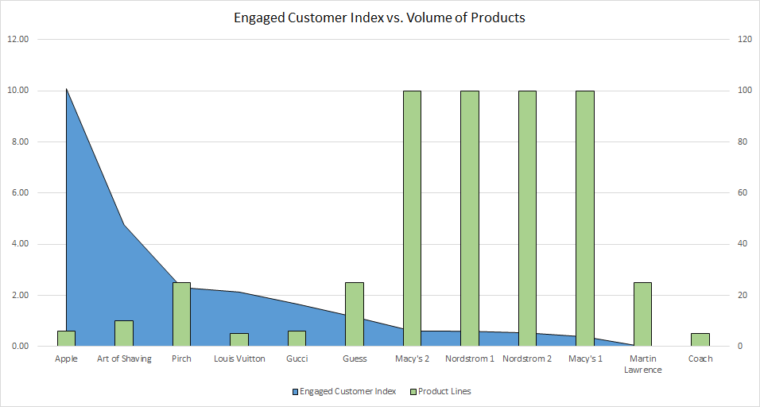 To compare customer engagement and product inventory I created an index value for engaged customers essentially detecting how many people in a store were engaged with a product or employee. I also asked for or counted the number of product lines defined for this research as a brand + style (and capped at 100 for my sanity). This chart shows that higher product volume doesn’t mean better consumer engagement.
To compare customer engagement and product inventory I created an index value for engaged customers essentially detecting how many people in a store were engaged with a product or employee. I also asked for or counted the number of product lines defined for this research as a brand + style (and capped at 100 for my sanity). This chart shows that higher product volume doesn’t mean better consumer engagement.On this trip, it seemed apparent that consumers are either selecting to shop/browse branded stores, stores with limited product lines, or some mixture of both.
Ways to mix the demands of physical and digital shoppers might be:
- Limit product lines in store to only the best-selling varieties, lead consumers to see alternatives on your website with NFC, QR codes, or other ways
- Stop creating mazes of towering racks hoping to trap consumers
- Make use of empty space to encourage consumers to be more comfortable and explore more
- Allow customers to order products using the Korean concept of ‘virtual retail,’ which shows the product on a screen along with a code to add products and order from a fashion retailer’s app on the consumer’s phone
- Stop spraying perfume everywhere (this has nothing to do with inventory, it just annoys me)
The Retail Experience
While at NorthPark Mall, there was a young lady playing and singing the song “Desperado” on a baby grand piano. She had a group of 10-20 people watching, taking photos, and paying attention. That’s not a huge crowd, but I stopped and listened for a song, as did many others. Malls have long known that to drive foot traffic they needed to provide an experience; it’s time retailers learn this lesson too.
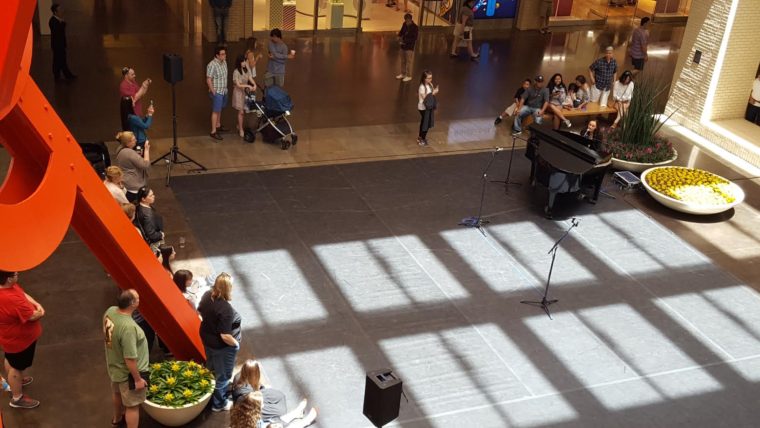
Providing an experience shouldn’t come out as forced, it should flow naturally and be part of a company’s culture. While this article is about fashion retail, I stumbled into an interesting home furnishings store called Pirch that uses the concept of providing an experience.
Pirch utilizes a wide open format, something that scares most retailers, and greets customers walking in with a large bar and friendly greeting asking if you’d like a complimentary beverage. The store’s director told me they encourage people to just come in and relax for a beverage and don’t utilize high-pressure sales tactics. The formula seems to be working as Pirch is currently in Atlanta, Dallas, Chicago, Glendale, San Diego, and will be expanding to Manhattan soon.
Small retailers may not have the space, the staff, or the funds to bring in talented performers or build extensive experiences, however; there are other ways to create an experience for brick and mortar consumers. Check out the local options you have available and see what fits into your marketing budget.
Ideas for creating an experience in your physical stores include:
- Renting inflatable games, bounce houses, and water slides
- Installing highly customizable arcade games like the VPCabs pinball machines shown on Shark Tank recently that you could have match product promotions
- In-store DJ’s / musicians from the local area
- Portable climbing rock walls
- Product launch/release party’s with an open bar
- Release party for a local band’s new album
- Limited time display gallery of local artists works
- Mixers for local social media / marketing / business networking / startup / other groups
- DIY classes / instruction
- Fundraiser for a local charity
If the experience you’re providing is done right, you’ll get social credibility by way of check-ins, photos, and hashtags.
If the experience you’re providing is a one-off event like a mixer or inflatable game, then setup event invites, submit to local event listings, and make sure to promote the event to your current customer base.
2. Where’s the Service?
I needed to get my Michael Kors watch band fitted to my wrist. I went into Nordstrom and found a well-dressed young man with a lapel mic moseying about in an area with shelves stacked with shiny watches in nicely packaged cases. I figured I was in the right place and politely asked if he could fit my watch band. He told me that he was not the right person, but that if Nordstrom sold that watch brand they would happily fit it for me. He sent me over to the jewelry department.
Once there, I asked a lady if she could fit my watch band and she said that she couldn’t and sent me over to another counter. The lady behind this counter said she could definitely help me and did a great job fitting my watch band, but didn’t exactly seem excited about it, I got a distinct impression this wasn’t something she wanted to do. Once finished I asked if I could buy another watch band to fit onto a novelty Star Wars watch I bought recently on impulse at another store, she told me no but I might be able to find another store in the mall to do this. That store, Fast-Fix, had a line out their small shop, but they were quick, knowledgeable, and happy to help me. The exact opposite of the lady and staff at Nordstrom.
After this, I wondered why I was unable to discover how to get my watch band fitted at Nordstrom. It turns out their website doesn’t even appear to discuss this service at all. A Google search query for “site:nordstrom.com watch fitted” lists product after product but can find no mention of them offering this service in their stores. Even if you’re buying a watch on their site there is no mention of band fitting. There are others asking this question too, and Nordstrom doesn’t appear to be paying attention. If they had asked me to make an account so they could save my wrist size (it has, unfortunately, been unchanged since I was 14) and I could buy watches online and ready fit for my wrist I would have done it and been more likely to buy online or in their physical store.
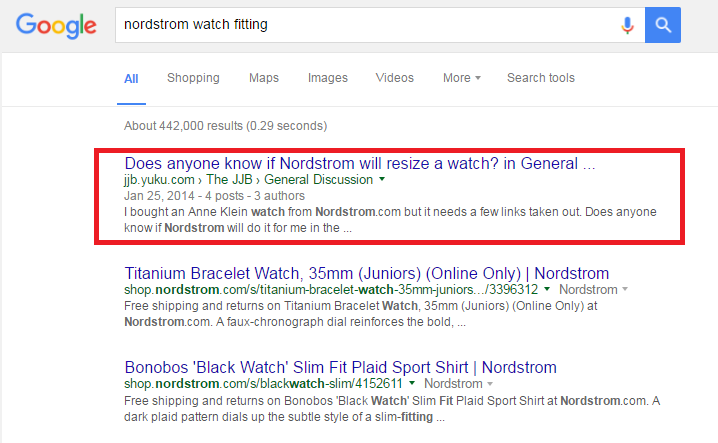
Fashion retailers can drive more foot traffic by improving their service offerings in various ways, such as:
- Using SEO and ranking for service related queries that they offer
- Having courteous and helpful staff
- Providing a personal shopper touch making physical buyers feel more important and special
- Saving sizing information and making it available in the store. (i.e. Men’s Wearhouse)
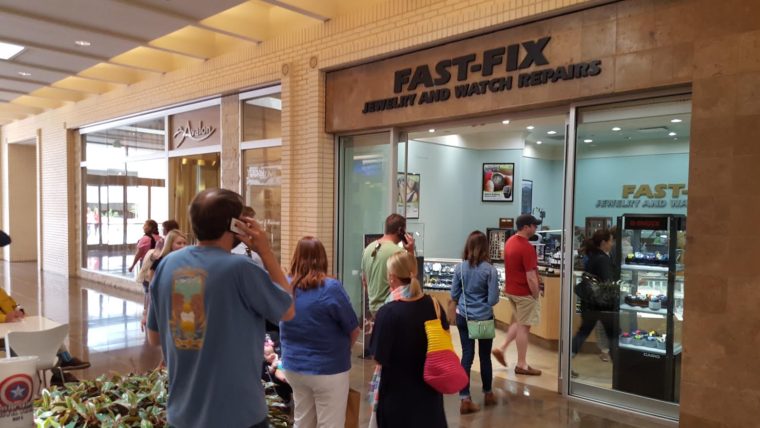 A line formed on a Saturday afternoon at a small shop that fixes and fits watches.
A line formed on a Saturday afternoon at a small shop that fixes and fits watches.3. Help Consumers Stay Connected
In-store wifi seems to be fairly ubiquitous among retailers. I’m unsure of which stores in the mall have it or allow customers to use their wifi though, and I’m going to guess I’m not alone. Fashion retailers can use a big QR code to allow fast connection to their WiFi without password issues or other complications. Once connected the wifi, they can redirect customers to a mobile page for their phone OS type.
This page can be used to:
- Encouraging app downloads
- Show upcoming events
- Explain the store’s culture or purpose
- List social media accounts and hashtags used
This seems like a pretty big missed opportunity for any store offering free wifi connection and trying to communicate to a digital audience.
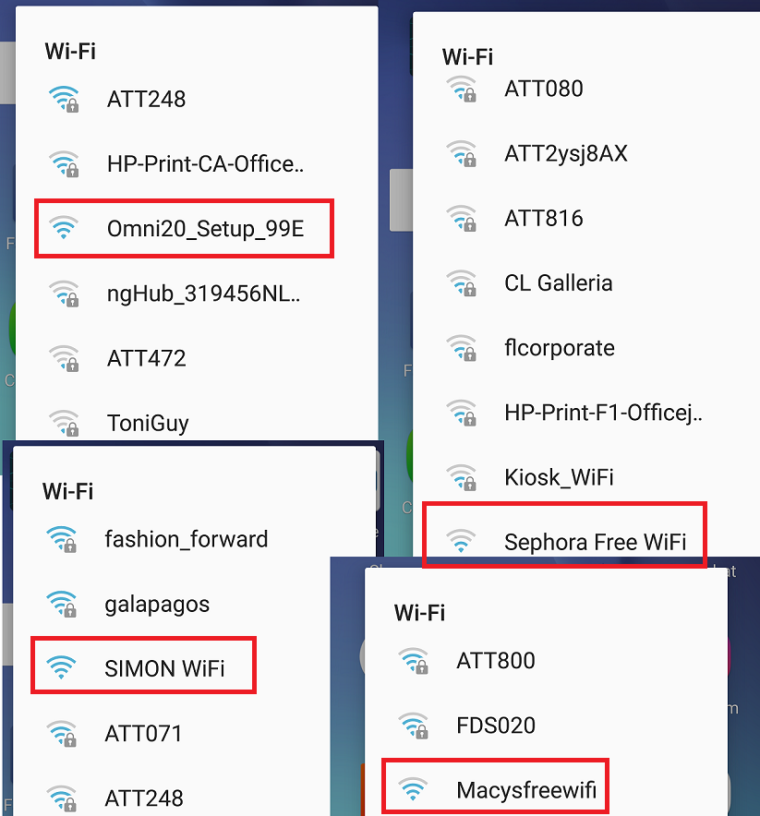 Plenty of shops at the Galleria Mall in Dallas, TX have wifi but many of them are locked.
Plenty of shops at the Galleria Mall in Dallas, TX have wifi but many of them are locked.4. How Many Stars Is This Product?
Showrooming is a big problem for retailers and yet the only solution most stores use is the ‘internet price match guarantee’. I was in an electronics store recently that had a QR code located on the product label that I could scan and see more information on their website, I loaded it and read reviews then purchased in-store, knowing I was likely paying $5-$10 more. I want to see Macy’s, Nordstrom, JC Penney, etc. do this, or even take it further.
To beat Amazon, you’ll likely need to out-innovate them and inform the consumer better. One possible such source could be those 5 golden stars. In each section of your department store, why not make a nice kiosk showcasing 5-star products from your website. Use QR codes to allow savvy shoppers to access the reviews and make their purchase decision while still in your store.
You could hire a marketing innovation laboratory such as Barkely USA’s Moonshot, Chaotic Moon, or my own Winner Winner Chicken Dinner, and create your own LCD labels that show a running list of verified reviews, or with the average rating, or the stars themselves on high-value products straight from your website.
5. Speak the Right Language
The specialty store, The Art of Shaving, has this neat shelf called “This is What’s Trending”, it doesn’t really say how they know what is trending or where they get this data from, however, the nomenclature is targeted at those young digital millennials who understand the meaning. I walked past this store three times on my trip and all three times a crowd of four to five young teens were looking at this specific shelf.
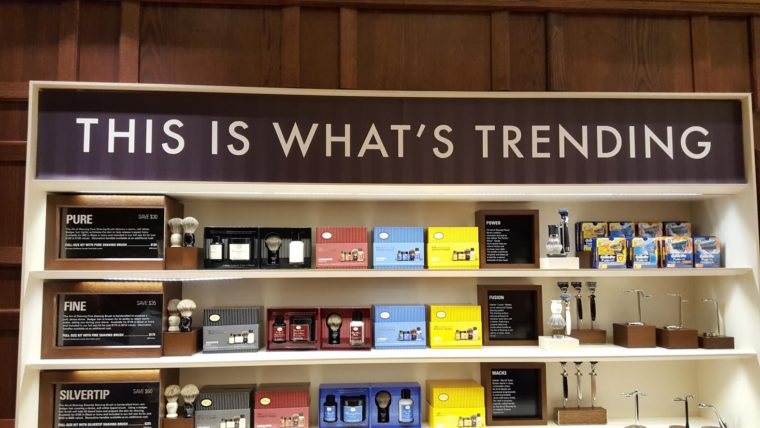
Macy’s, on the other hand, is swinging at the social media fluent audience like a blindfolded child trying to hit a piñata with a really small bat. They recently announced their #MacysLove campaign, which would put your photos on a billboard in Times Square. Running on Instagram and Twitter the campaign tells people to “Snap & share your latest Macy’s finds.”
So far the customers are not snapping, and the campaign is flopping. The Twitter version is getting on average four tweets per hour according to measurement tool RiteTag. Since the campaign was announced in an April 1st Facebook post, getting 125k likes/reactions, it has only gotten a total of 1,371 posts on Instagram.
Even worse, the company isn’t active in their own hashtag for this campaign retweeting, liking, replying – nothing.
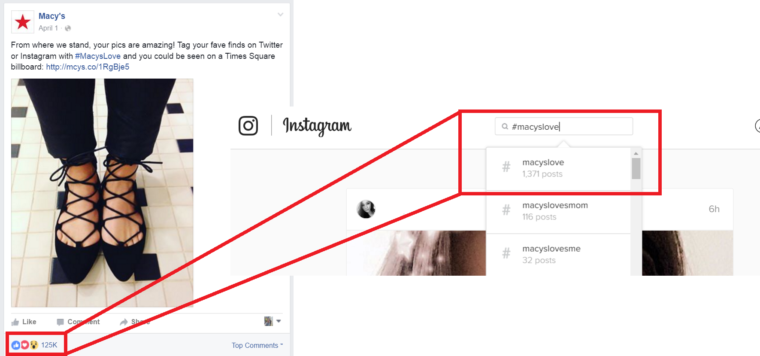 Macy’s announced a campaign to show their fashion on a Times Square billboard on April 1st which has garnered them very little engagement from customers
Macy’s announced a campaign to show their fashion on a Times Square billboard on April 1st which has garnered them very little engagement from customersFashion retailers can bring styles, design, and the need to be recognized down to a more local level and show they care by interacting with their audience more. Some ways to do this include:
- wifi Photo Gallery: Don’t just use the right nomenclature, but use the right reward, too. Instead of plastering people in Times Square, put a wifi enabled screen at one entrance in each store showcasing selected posts from the hashtag. Then take pictures of people being featured and tweet those photos to them / tag them on Instagram and make sure to mention the store
- Trending Screen: Setup a trending screen in each major department and have a team of editors curate the trending items for that section in that store. Base this on the activity in social media and the sales of the store. The more an item sells the hotter it gets, the hotter it gets the more it should be on the trending screen
- Snapchat Geofilters: Seriously, I was surprised and shocked that neither Macy’s nor Nordstrom at either mall used a Snapchat geofilter. But weirdly enough, Sephora did, and so did Express. That was it, no other stores had them. It’s not like they are expensive to have designed or to run on the platform, starting at about $5 and averaging between $100 and $300. Large retailers like Macy’s can identify the best times and dates on a store by store basis using the provided analytics and place geofilters out during those times. You should also switch it up or offer more than one option at a time, experimenting with messages that get more spread
6. It’s Time for Social Media Videos That Don’t Suck
Macy’s recently made a video for Mother’s day that got 193 reactions on their Facebook – out of the 14,000,000 people who like their page. This comes out to 0.0000136% engagement. It seems that in 2014 through early 2015 Macy’s had a really big focus on social media videos, but couldn’t shake the idea of using the same old fashion ads the industry has always made. (You know, pretty people doing pretty people things.) They also feel just a little off and out of sync, rarely packing any messages worth seeing or hearing frequently ending with an overly complicated call to action. While these videos drove high view counts, they did not get shared well, garner very many likes or reactions, some attracted mostly negative comments, and it seems eventually Macy’s gave up on it.
Instead, fashion retailers can follow the trends and make use of these kinds of videos.
- Helpful Videos: Unless you don’t use social media at all, you’ve likely noticed a plethora of videos telling you how to cook meals, apply makeup, or discussing recent technology pouring into your Facebook / Twitter feed. These videos are typically shot top down or straight on and use no voice overs, just text on the video to describe the steps with a sound bed. Fashion retailers could make videos in a similar style answering common questions like how to tie a bow-tie, different types of shoes, or to show off new styles and how to coordinate them together
- Facebook 360-degree videos: A few select Macy’s stores recently had fashion shows for Prom apparel. Finding mention of it was pretty difficult, let alone any coverage by the brand itself. However, users uploaded their own not-quite-high-quality videos to the hashtag #MacysProm on Twitter. Instead, when doing events like this Fashion retailers could hire video production firms to make 360-degree videos putting the Facebook audience in the action
Videos could help drive local brand awareness through geographic targeting in Facebook and could lead to higher foot traffic. Some fashion retailers set up Facebook pages, Twitter accounts, etc. for each local store.
7. Toss out the Mannequins
It is time to get rid of those creepy half-headed, shiny-bodied, weird posing mannequins. The cutting edge of technology is not only an experience that will bring in shoppers, but it’s also a great sales tool that could help fashion retailers regain credibility and push more sales through their physical brick and mortar stores.
- VR/AR Models: You could partner with HTC/Samsung/Microsoft/META and make virtual reality or augmented reality apps that allow users to see not just the clothing in your store, but the various online options, you have as well. With large stores like Macy’s and Nordstrom, this could allow users to find and buy products in-store from the website.
- Smart Mirrors: If Snapchat can augment your face to look like an alien or add weird flowers to it, then why can’t retailers use that same technology built it into a smart mirror, and allow consumers to see how products such as hats, glasses, shirts, pants, shoes, and accessories might look on them. Built with Android and using hand gesture recognition technology like Microsoft Kinect, smart mirrors could bring a store’s available and online inventory to life for a consumer. A few swipes of the hand to the right or left and you could change out the clothes or accessories allowing, customers to see in minutes what would normally take an hour or longer, and helping empower and inspire them to make a purchase
- Hologram Runway: It’s time for holograms to find a real world use beyond bringing Tupac
out of seclusionback from the dead to perform on stage. I propose big retailers install a hologram runway in their flagship locations. Here, a consumer would walk into a small booth and be scanned into a 3D model. That 3D model would then be rendered on a runway with various clothes and accessories. Model after model would walk past showing how the person would look in certain clothes and outfits. At any time, the customer can select the outfits shown they like and checkout. If in-stock, they can leave with the product, and if not it can be shipped right to them. Rezin8 is the company that built the Tupac Hologram for Coachella in 2012, and they could likely be talked into building such a system for your store. Rumor is Hologram Tupac cost a maximum of about $400,000. That’s a pretty good investment for big brand retailers if it can stem their losses or even grow sales.
In his 2007 TED talk “How to get your ideas to spread” Seth Godin said,
“The riskiest thing you can do now is be safe…the safe thing to do now is to be at the fringes, be remarkable.”
Macy’s, Nordstrom, Target, or any other retailer who sells fashion needs to take that to heart before it’s too late and the carcasses of their abandoned stores dot the roadsides of America, like so many gas stations do today.
Trying
For their part, Macy’s does at least appear to be trying, the NorthPark Mall location now has an area where online orders can be picked up, phones can be charged, and employees can help consumers access the website. Like most of their digital technology efforts, though, it still feels like they aren’t able to connect with their digital and tech-savvy audience very well. Maybe soon they’ll find the magic mixture of physical goods and digital technology.
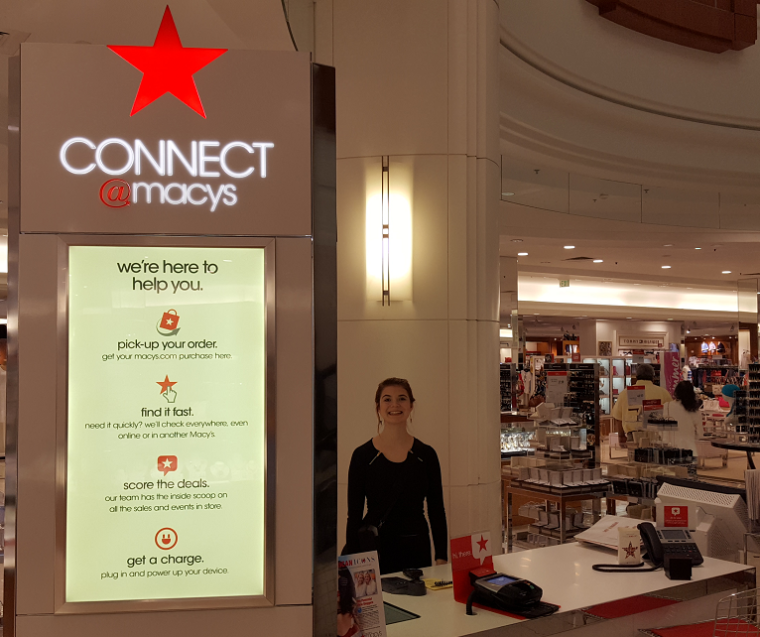 Macy’s employee Amelia Brietbach at the “Connect” desk where shoppers can charge their phone and pick up online orders.
Macy’s employee Amelia Brietbach at the “Connect” desk where shoppers can charge their phone and pick up online orders.TL;DR Recap
- Drive foot traffic not by having sales week after week, but with interesting experiences that capture customers’ attention and by providing helpful services that make them want to come back again and again. If you offer services, make sure you have those on your website and work to rank for them. Services are more difficult for digital-based competitors to offer.
- Leverage QR codes or NFC tags to allow customers to access your wifi painlessly, download your apps, and shop products on your website while still in the store.
- Cut down on showrooming and showcase high-value products from your website that are highly rated with in-store static and digital displays.
- Understand your audience and the language they speak better and integrate terminology into your store displays and messaging. If you run social media campaigns, make sure the campaigns engage with your audience both digitally and in the real world.
- Get local attention by creating videos that get local spread. Make sure to use geo-targeted posts on Facebook if you have just one page for all locations. Experiment with 360-degree videos if and where it makes sense.
- Experiment with cutting edge technology solutions such as a smart mirror and holograms to entertain and act as a utility for consumers.
- Stop spraying so much perfume in your stores.
Image Credits
Featured Image: Brooke Cagle / Unsplash
Screenshots by Joe Youngblood. Taken May 2016
All other photos by Joe Youngblood. Taken May 2016





